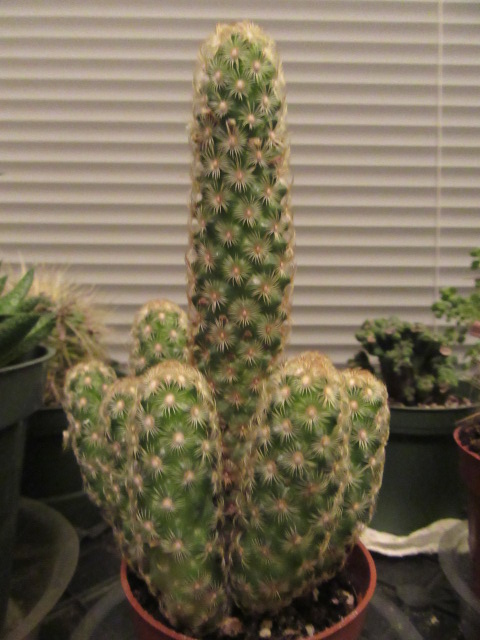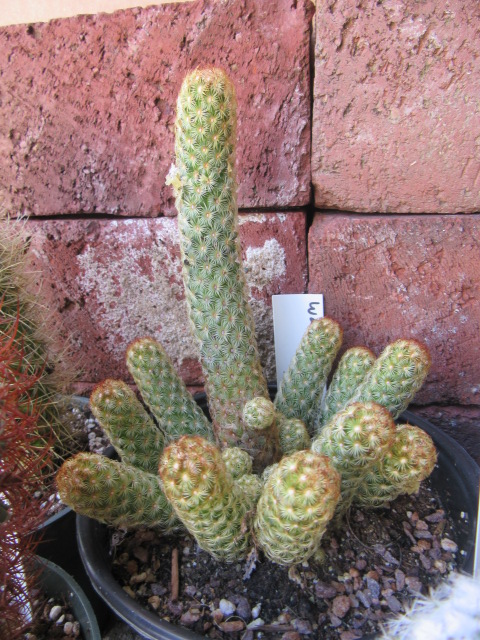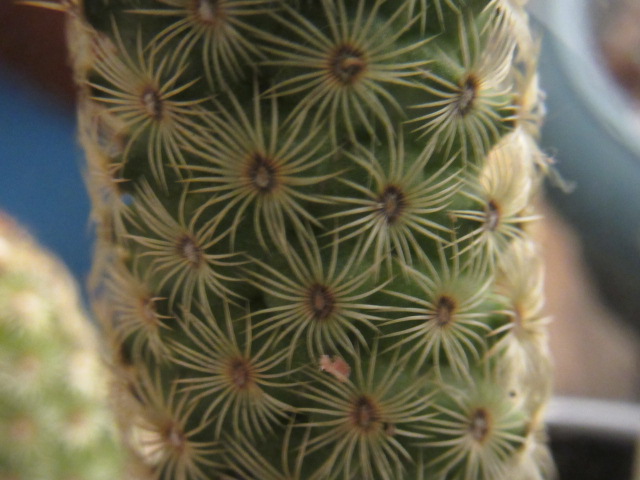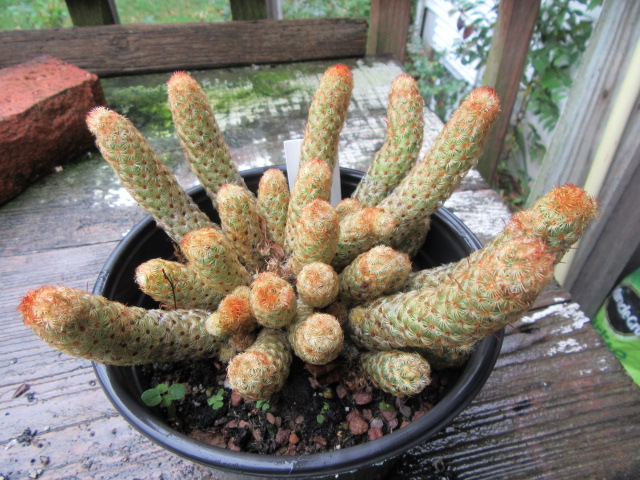
Mammillaria elongata (Ladyfinger Cactus) on 10-15-20, #747-65.
Ladyfinger Cactus, Golden Stars
Mammillaria elongata
mam-mil-AR-ee-uh ee-long-GAH-tuh
ROYAL HORTICULTURAL SOCIETY AWARD OF GARDEN MERIT
Synonyms of Mammillaria elongata (58) (Updated on 12-8-23 from Plants of the World Online): Cactus anguineus Kuntze, Cactus densus (Link & Otto) Kuntze, Cactus elongatus (DC.) Kuntze, Cactus intertextus Kuntze, Cactus minimus (Rchb.) Kuntze, Cactus pulvilliger Kuntze, Cactus rufocroceus (Salm-Dyck) Kuntze, Cactus stella-aurata (Mart. ex Zucc.) Kuntze, Cactus subcroceus (DC.) Kuntze, Cactus subechinatus (Salm-Dyck) Kuntze, Cactus tenuis (DC.) Kuntze, Chilita echinaria (DC.) Orcutt, Chilita elongata (DC.) Orcutt, Krainzia elongata (DC.) Doweld, Leptocladia echinaria (DC.) Buxb., Leptocladia elongata (DC.) Buxb., Leptocladodia elongata (DC.) Buxb., Mammillaria anguinea Otto ex Salm-Dyck, Mammillaria caespitosa Salm-Dyck ex J.Forbes, Mammillaria densa Link & Otto, Mammillaria echinaria DC., Mammillaria echinata DC., Mammillaria echinata var. densa Pfeiff., Mammillaria elongata var. anguinea K.Schum., Mammillaria elongata var. densa (Link & Otto) Schelle, Mammillaria elongata subsp. echinaria (DC.) D.R.Hunt, Mammillaria elongata var. echinata (DC.) K.Schum., Mammillaria elongata var. erecta Schelle, Mammillaria elongata var. intertexta (DC.) Salm-Dyck, Mammillaria elongata var. minima Schelle, Mammillaria elongata var. obscuriora Heinrich ex Backeb., Mammillaria elongata var. rufescens Salm-Dyck, Mammillaria elongata var. rufocrocea (Salm-Dyck) K.Schum., Mammillaria elongata var. schmollii Borg, Mammillaria elongata var. stella-aurata (Mart. ex Zucc.) K.Schum., Mammillaria elongata var. subcrocea (DC.) Salm-Dyck, Mammillaria elongata f. subcrocea (DC.) Schelle, Mammillaria elongata var. subechinata (Salm-Dyck) Schelle, Mammillaria elongata var. tenuis (DC.) K.Schum., Mammillaria intertexta DC., Mammillaria minima Rchb., Mammillaria rufocrocea Salm-Dyck, Mammillaria stella-aurata var. gracilispina Salm-Dyck, Mammillaria subcrocea DC., Mammillaria subcrocea var. echinata (DC.) Y.Itô, Mammillaria subechinata Salm-Dyck, Mammillaria tenuis DC., Mammillaria tenuis var. media DC., Neomammillaria echinaria (DC.) Britton & Rose, Neomammillaria elongata (DC.) Britton & Rose, Neomammillaria subcrocea (DC.) Y.Itô, Neomammillaria subcrocea var. echinata (DC.) Y.Itô
Mammillaria elongata DC. is the accepted scientific name of this cactus. It was named and described by Augustin Pyramus de Candolle in Mémoires du Museum d’Histoire Naturelle (Paris) in 1828.
The genus, Mammillaria Haw., was named and described by Adrian Hardy Haworth in Synopsis Plantarum Succulentarum in 1812.
As of 12-8-23 when this page was last updated, Plants of the World Online by Kew lists 138 species in the Mammillaria genus. It is a member of the plant family Cactaceae with 150 genera. Those numbers could change as updates are made on POWO. The number of species in the genus and genera in the family fluctuates off and on.
THERE ARE SEVERAL LINKS AT THE BOTTOM OF THE PAGE FOR FURTHER READING.

Mammillaria elongata after I brought it home on 3-19-18, #418-13.
I brought this cactus home from Walmart on 3-19-18. The cluster measured approximately 5 3/4” tall at the tallest point and 3 3/4” at the widest. There are 12 “stems” in a 2 3/4” diameter x 2 1/4” tall pot. There are remnants of several yellow flowers or buds yet to flower. Finally, I have a cactus that will have yellow flowers! Of course, there were several “strawflowers” hot glued to this which I managed to remove fairly well. You have to be careful when you do that…
Information on the Llifle website says, “Mammillaria elongata is a succulent ground cover, in time forming tight clumps of erect, ascending, prostrate or recumbent stems. This may be the most common Mammillaria to be found and occurs in more variations than any other Mammillaria species. It commonly comes in many color and spine variations.”

Mammillaria elongata on 5-17-18, #443-60.
Once temperatures allowed, I moved the potted plants back outside for the summer. Not long after I brought this cactus home, I accidentally knocked it on the floor. Most of the “fingers” fell off and I had just stuck them back in the pot.

Mammillaria elongata in its new pot on 5-25-18, #448-11.
I put the Mammillaria elongata in a larger pon on May 25. The “fingers” I had stuck in the pot previously had a few roots so I made a hole for them and stuck them deeper into the soil.

Mammillaria elongata on 6-28-18, #465-17.
On June 28 I noticed a fruit where one of the flowers had been. I never had a cactus produce fruit before. (Well, I think the Prickly Pear in Mississippi had fruit in 2012).
USEFUL INFORMATION:
Family: Cactaceae
Origin: Northeast Mexico
Zones: USDA Zones 9b-11 (25-40° F)
Size: Ummm.
Light: Sun to light shade.
Soil: Fast-draining. Potting soil amended with extra perlite and chicken grit (2-1-1) or a 50/50 mix of potting soil and pumice.
Water: Regular water in summer, barely in winter.
Flowers: Variable. Pale yellow to pink shades.
You can read my Cactus Talk & Update and Cactus & Succulent Tips to get my opinion about growing cacti and succulents.
When you bring your new plants home from the store, you need to check their roots and the soil to see if they are wet. If so, you may want to re-pot it right away. It is advisable to re-pot them in a better potting soil more suitable for cacti and succulents.

Mammillaria elongata on 7-29-18, #498-67.
The Mammillaria elongata continues to well and is now growing more offsets around the main stem.

Mammillaria elongata on 8-18-18, #498-3.
After I took the photo on July 29 she started leaning over. In the above photo, you can also see all her new kids. It would be pretty neat if they grew straight up, but they are supposed to kind of trail. You can put them in hanging baskets and allow them to trail over the sides but that may take some time…

Mammillaria elongata on 8-26-18, #499-26.
Doing well, although somewhat weird…

Mammillaria elongata on 10-10-18, #519-45.
Cool weather was approaching and an “F’ was in the forecast when I moved the potted plants inside for the winter on October 10. I always measure the cactus and succulents when I bring them inside, but I had no idea where to begin with this one… There are 11 larger offsets averaging 2 1/4″ long and 15 small offsets. One of the larger offsets also has 2. The original stem is 6 1/4″ tall (or long). It was 5 3/4” tall when I brought it home.

Mammillaria elongata on 11-29-18, #534-17.
November 29 was a nice spring-like day, so I took the cactus outside for a photoshoot. I was starting a new post showing the difference between the cactus species in my collection.

Mammillaria elongata close-up on 12-1-18, #535-12.
Now, that photo came out very well! Twenty-six radial spines, more or less, re-curved, white to yellowish. Central spines are usually absent on MOST areoles. You can actually put your hand around the stems, which is when you find the central spines. Then they will be in your fingers and not on the cactus.
<<<<2019>>>>

Mammillaria elongata on 5-25-19, #576-52.
The Mammillaria elongata and the rest of the cactus, succulents, and other potted plants made it through the winter with flying colors. We were all glad when the temps warmed up enough to be back outside for the summer. I put most of the cactus on the back porch where they could get full sun.

Mammillaria elongata on 6-22-19, #593-27.
There are a lot of kids in this pot… Even the kids have kids. The main stem is a bit of a leaner. One way or another and sometimes straight up.

Mammillaria elongata on 10-11-19, #639-58.
I had to move the potted plants inside for the winter because of an “F” in the forecast. As always, I took photos of all the plants and measured the cactus and some of the succulents. For some reason when I looked at the size I wrote down for the Mammillaria elongata it says 6 5/6″ tall. What in the heck does that mean anyway? It was 5 3/4″ tall when I brought it home from Wal-Mart in March 2018. There were also a few buds when I brought it inside.

Mammillaria elongata on 10-19-19, #643-4.
As always after the first “F” the temps warmed back up again. The cactus always give me dirty looks when this happens so I put them back on the porch for a few days.

Mammillaria elongata on 11-2-19, #646-3.
November 2 was a nice spring-like day so I took the Mammillaria elongata and a few other cactus outside to take some photos of their flowers.

Mammillaria elongata flowers on 11-2-19, #646-4.
NICE! When my first Mammillaria started flowering they were all pink. I am glad to have several now that are creamy white.
<<<<2020>>>>

Mammillaria elongata (Ladyfinger Cactus) on 10-15-20, #747-65.
I had to bring the potted plants inside for the winter on October 15 because an “F” was in the forecast. As always, I took photos and measurements.

Mammillaria elongata (Ladyfinger Cactus) at 6 1/8″ long/tall x 7″ wide on 10-15-20, #747-66.
This time, the main stem in the center measured 6 1/8 ” long, or tall, and the whole cluster was 7″ wide. It isn’t uncommon for cactus to shrink or swell depending on water uptake and humidity. I had watered the cactus the day before I brought them inside thinking they would swell somewhat by the time I took measurements. Apparently, it may take a while. I measured the center cactus AGAIN on November 2 when I am updating this page and it was about 6 3/4″ tall…
When I was writing a Mammillaria update on November 14 in 2020 I took another measurement. The main stem, or whatever you call it, was standing straight up and it measured 7 3/8″ tall. GEEZ!
<<<<2021>>>>

Mammillaria elongata (Ladyfinger Cactus) on 10-28-21, #853-13.
I didn’t have to move the potted plants inside for the winter until October 28 in 2021. There wasn’t a chance of “F” in the forecast until then which was quite unusual. The Mammillaria elongata continues to go bananas. The longest stem in the center of the pot broke in half over the winter and then died. Now the longer stems measure from 3 to 3 3/4″ long. I counted 39 stems and offsets and some are very tiny. There are even offsets growing along some of the taller stems. Hmmm… I should have taken a photo from a different angle but I was in a hurry. There was one stem with 11 offsets when I brought this plant home from Walmart in 2018.
Unfortunately, this plant died over the summer in 2022. Now I will have to find another one…
There is a lot of information on the Llifle website including how to grow them, so please click on the link below for further reading.
I will add more photos and information as time goes by. If you have any comments, questions, or suggestions, I would like to hear from you. Please click on “like” if you visited this page. It helps us bloggers stay motivated. 🙂 You can check out the links below for further reading. The links take you directly to the genus and species of this plant.
The photo of M. elongata looks like a perfect plant. I have four varieties and all of mine are decumbent. I like the erect look of that plant. Looks healthier. I always re-pot everything I buy at the “Big Box” stores because they are invariably potted in a mix that has too much peat , that I find,
stays wet too long. .
LikeLiked by 1 person
Hello there Anonymous! I rather like the erect look better for this Mammillaria as well. Not long after I bought this plant I knocked it on the floor and most of the pieced broke off the plant. I just stuck them back in the pot to see what would happen. I agree, the cactus and succulents bought from “box” stores need to be repotted. The soil is wrong, they are overwatered, and many are mislabeled. Thanks for the comment and thanks for visiting! It would be nice to know your name, though. 🙂
LikeLike